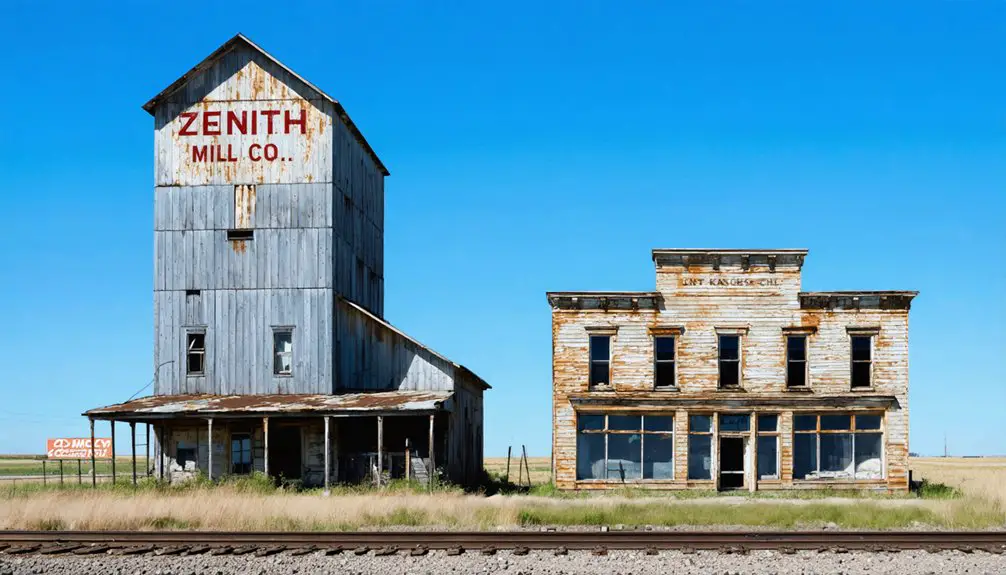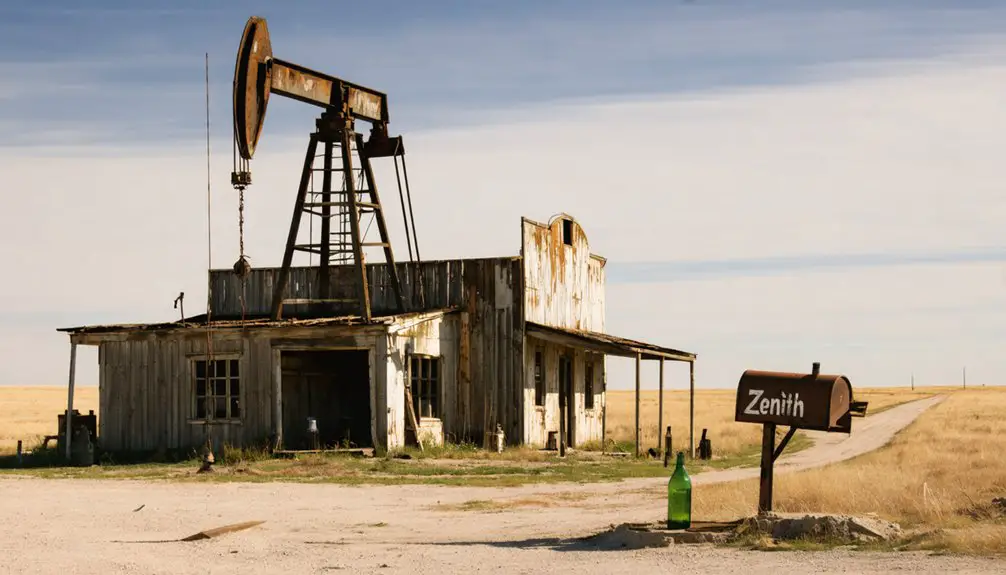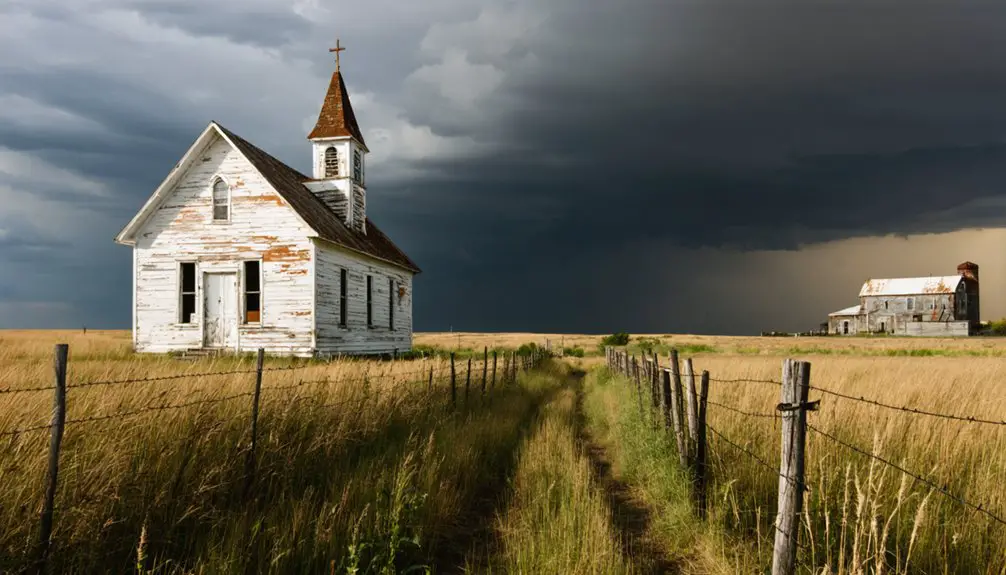You’ll find Zenith’s ghost town remains in Stafford County, Kansas, where railroads first transformed a small settlement called Sylvia in the 1880s. The town flourished with general stores, saloons, and a farmers’ elevator until 1937, when oil discovery brought brief prosperity during WWII. Today, abandoned buildings and empty grain elevators stand as silent witnesses to the prairie settlement’s rise and fall, each structure holding untold stories of Kansas frontier life.
Key Takeaways
- Originally named Sylvia, Zenith was established in the 1880s after relocating six miles west due to railroad development.
- The town experienced its peak during the 1930s oil boom, producing 23 million barrels of high-quality oil.
- Economic decline began when Highway 50 redirected trade away and agricultural mechanization eliminated farming jobs.
- Key infrastructure included the Farmers’ Elevator, Presbyterian church, and schoolhouse, which now stand abandoned.
- Farm consolidation, population exodus, and shifting transportation routes transformed Zenith from a thriving community into a ghost town.
From Sylvia to Zenith: The Origins of a Prairie Town
While many prairie towns shifted locations to accommodate railroad development, Zenith’s origin story stands out for its unique name swap with neighboring Sylvia.
You’ll find the pioneer challenges of establishing a permanent settlement reflected in the town’s early movements, as the original Sylvia relocated six miles west when the railroad came through in the 1880s. The growth of the community led to the establishment of a thriving general store and blacksmith. The community dynamics of the era shaped this change, with the post office following suit in 1886.
The name “Zenith,” meaning “highest point attained,” carried symbolic weight for these ambitious settlers. When the original settlement took the name Sylvia, the new railroad-adjacent location claimed Zenith as its identity, marking a strategic pivot that would define the town’s future development patterns. The town later reached its peak during the 1930s when oil was discovered, transforming it into a bustling energy hub.
Early Pioneer Settlement and Commercial Growth
Tom Anderson established Zenith’s first commercial venture in 1874 when he opened the town’s pioneer general store to serve early settlers.
You’ll find that Anderson’s store marked the beginning of Zenith’s commercial development, which later expanded to include essential prairie businesses like a blacksmith shop, cream station, and lumberyard.
The arrival of the Atchison, Topeka & Santa Fe Railroad in the mid-1880s accelerated the settlement’s growth, prompting new businesses to establish themselves near the rail line. Similar to Columbia, Kansas, which boasted a log store and blacksmith among its first structures, Zenith followed a typical pattern of early frontier commercial development.
The town experienced significant changes when it was named Sylvia in 1886 by A.A. Robinson in honor of his wife.
Anderson’s First General Store
The establishment of Anderson’s First General Store in 1874 marked a pivotal moment in Zenith’s commercial development.
You’d find Tom Anderson’s store nestled among the blacksmith shop, cream station, and lumberyard, serving as a crucial hub for community gatherings and essential store inventory. The store’s influence extended beyond basic commerce, shaping the town’s early growth and pioneer trade. Much like John Anderson T.B.A. in Livingston County, the business demonstrated remarkable adaptability in meeting evolving community needs. Similar to Central City’s first store built by W.S. Eastwood in 1858, it became an important trading center for the region.
- Initially established in the original Zenith settlement before relocating with the post office to Sylvia in 1886
- Expanded to include Studebaker and Buick automobiles by 1914, adapting to changing times
- Operated under partners Bert McComb and Bill Johnson in the 1910s, demonstrating local entrepreneurial spirit
The store’s strategic location and diverse offerings made it indispensable to settlers and farmers until economic shifts triggered the town’s decline in the 1920s.
Railroad Influences Settlement Growth
As railroads expanded across Kansas in the 1880s, Zenith’s destiny changed dramatically when the Atchison, Topeka & Santa Fe Railroad’s planned route sparked a crucial shift in 1886.
Like astronomical zenith points marking the highest path, the railroad’s development represented the peak of the town’s potential growth. The railroad’s influence prompted the establishment of a new town site called Sylvia, where the post office relocated from original Zenith. You’ll find that settlement patterns quickly evolved as the railroad brought essential commercial infrastructure including a general store, blacksmith shop, and cream station. This growth aligned with the era’s intense railroad building that transformed communities across the state.
The 1905 construction of the Farmers’ Elevator marked a turning point in local trade, while Presbyterian church construction and bank organization followed by 1914.
You can trace railroad expansion’s impact through the area’s development, from the 1885 organization of Sylvia’s school district to the emergence of auto dealerships selling Studebakers and Buicks.
Railroad’s Role in Shaping the Community
When railroad tracks first reached Zenith in the 1880s, they fundamentally transformed this Kansas settlement’s identity and development trajectory.
The arrival of railroad tracks in 1880s Zenith marked a pivotal moment, forever altering the Kansas settlement’s future path.
You’ll find that the railroad infrastructure reshaped everything from the town’s name – changing it from Zenith to Sylvia – to its physical layout, as businesses and services realigned along the tracks. Similar to the Scott Special train, which set speed records in 1905, these rail lines represented the pinnacle of transportation innovation.
These transportation shifts sparked rapid growth, leading to the establishment of crucial commerce centers and distribution networks. Like many dead Kansas towns, Zenith’s prosperity was directly tied to the presence of vital transportation infrastructure.
Key changes the railroad brought to Zenith:
- Establishment of essential businesses including a general store, blacksmith shop, and cream station
- Creation of the Farmers’ Elevator in 1905, revolutionizing grain transport efficiency
- Development as a major distribution hub during the 1930s oil boom, handling over 800 barrels daily
The rail line didn’t just connect Zenith – it defined the town’s very existence and prosperity.
Religious and Educational Foundations
Religious foundations in Zenith emerged from humble beginnings, with early settlers gathering for Sunday school in a local lumberyard before any formal structures existed.
You’ll find that the Presbyterian church, built in 1911, became the town’s first formal place of worship and a central hub for religious gatherings.
The community’s educational priorities took shape in 1914 when they organized a school district.
You’d have seen children attending classes in the local schoolhouse until 1926, when Zenith’s high school merged with Stafford’s.
Both church and school served as pillars of the community during its peak years, fostering social bonds and intellectual growth.
While the high school’s closure marked a turning point in Zenith’s decline, it reflected the broader pattern of rural consolidation that you’d find throughout Kansas’s prairie settlements.
The Economic Peak Years: 1905-1914

You’d find Zenith at its economic height between 1905-1914, when the Farmers’ Elevator and multiple businesses, including a blacksmith shop, cream station, and lumberyard, served the growing agricultural community.
The town’s commercial success attracted retail partnerships that brought modern amenities like Studebaker and Buick automobiles to local residents by 1914.
Alongside this business growth, Zenith established key institutions including a Presbyterian church in 1911 and a formal school district in 1914, marking the town’s evolution from frontier settlement to established community.
Business Growth and Commerce
During Zenith’s peak economic years from 1905 to 1914, the town flourished with diverse commercial enterprises that served its growing population of nearly 2,000 residents.
Local entrepreneurship thrived as merchants like Bert McComb and Bill Johnson expanded their general stores, while trade networks strengthened through the town’s strategic railroad access.
You’d find these crucial businesses serving the community:
- The Farmers’ Elevator for grain storage and shipping
- A bustling blacksmith shop maintaining farm equipment and transportation
- Multiple general stores that evolved to include Studebaker and Buick dealerships
The commercial landscape reflected Zenith’s agricultural roots while embracing modern progress, with businesses like the cream station and lumberyard supporting the region’s growth.
The town’s economic liveliness also supported five saloons and gambling houses, showing the community’s prosperous spirit.
Church and School Expansion
As Zenith’s population surged past 1,500 residents in 1905, the town’s spiritual and educational infrastructure underwent significant transformation.
You’d find the Presbyterian congregation meeting in the town lumberyard for Sunday school until 1911, when they built their first permanent church. This marked a pivotal moment in institutional development, fostering greater community cohesion.
The town’s educational system evolved in parallel, with a limestone schoolhouse serving the growing population.
By 1914, you’d see the formal organization of Zenith’s school district, coinciding with the establishment of the local bank.
Students attended the high school until 1926, when it closed and they transferred to nearby Stafford. These institutions reflected the town’s prosperity and ambition during its peak economic years.
Challenges and Population Decline
While many Kansas towns faced hardships in the 20th century, Zenith’s decline stemmed from multiple economic blows that proved insurmountable.
The town’s economic stagnation intensified as key transportation routes shifted away, leaving local businesses cut off from essential markets. Dramatic demographic shifts followed as younger residents sought opportunities elsewhere, leaving an aging population behind.
As vital transport links vanished, Zenith’s businesses withered and young people fled, leaving only an elderly population to witness its decline.
Key factors in Zenith’s depopulation included:
- Agricultural mechanization that drastically reduced farm labor needs and led to widespread farm consolidation.
- Loss of manufacturing jobs as industries relocated to regions with lower operating costs.
- Reduced accessibility after railroad and highway routes changed, severely limiting the town’s commercial viability.
You’ll find evidence of this decline in Zenith’s deteriorating infrastructure and empty storefronts, reflecting the broader challenges of rural Kansas communities.
The 1937 Oil Boom Era

The 1937 discovery of oil in Zenith marked a transformative chapter in the town’s history, yielding over 23 million barrels from the Misener formation.
Oil exploration revealed high-quality 41° API gravity oil trapped within the region’s distinctive anticlinal fold near the Central Kansas uplift.
You’ll find the production techniques focused on two key zones: the lower Misener sandstone and limestone. While the field once sprawled across 9,100 acres, today’s operations cover just 2,000 acres.
The boom brought essential infrastructure development, including tank cars and pipelines, while Skelly Oil Company built facilities for processing gas liquids.
The discovery helped diversify the local economy beyond agriculture, creating jobs and bringing investment to the region during a pivotal period that sustained America’s energy needs through World War II.
Agricultural Changes and Their Impact
During the mid-20th century, sweeping agricultural changes transformed Zenith from a bustling farming community into a ghost town.
As sustainable agriculture gave way to mechanization, you’d have witnessed the dramatic shift that forced many residents into urban migration. The introduction of tractors and automated harvesters made small-scale farming economically unfeasible, while larger operations absorbed the smaller farms.
Here’s how the agricultural landscape changed:
- Farmland consolidation eliminated numerous tenant farming positions
- Highway 50’s development redirected trade away from Zenith’s markets
- Environmental challenges, including droughts and soil erosion, pushed farmers to abandon their land
You can still see evidence of this transformation in Zenith’s empty school building, which hasn’t housed students for nearly 50 years, and the abandoned grain elevators that once served as the community’s economic backbone.
Notable Buildings and Landmarks Through Time

Standing as silent witnesses to Zenith’s former prosperity, numerous historic buildings and landmarks chronicle the town’s evolution from a thriving agricultural hub to its current ghost town status.
You’ll find the 1936 City Hall‘s dressed stone architecture alongside the historic Presbyterian church, built in 1911. The stone-constructed schoolhouse, organized in 1914, now serves as a residence, while the old bank building reminds you of the town’s brief financial peak before its 1929 closure.
The Farmers’ Elevator, established in 1905, remains an active landmark, defying time’s passage. Notable architectural styles range from early commercial false fronts to sturdy masonry construction, reflecting Kansas’s rural heritage.
These structures, though many now vacant, represent crucial historical preservation of Zenith’s remarkable past.
Legacy of a Kansas Prairie Settlement
Located among Kansas’s windswept prairies, Zenith’s story reflects both the ambitions and challenges faced by countless frontier settlements during America’s westward expansion.
From its pioneer beginnings in 1874 to its eventual decline, this community embodies the economic transformation that shaped the American heartland.
You’ll find Zenith’s legacy preserved in three distinct chapters of prairie settlement history:
- Early pioneer resilience through essential services like Anderson’s store, the blacksmith shop, and community-built Presbyterian church
- Economic boom periods marked by grain elevators, auto dealerships, and the 1937 oil discovery
- The town’s evolution from Zenith to Sylvia, driven by railroad interests and changing settlement patterns
Today, with only 20 residents remaining, Zenith stands as a symbol of the dynamic nature of frontier development and decline.
Frequently Asked Questions
What Happened to the Original Residents of Zenith After It Became Abandoned?
Picture the Jones family packing their lives into wagons. Like most original residents, you’d have seen them relocate to Stafford and nearby towns after Zenith became a ghost town, seeking schools and jobs.
Are There Any Remaining Oil Wells Still Producing Near Zenith Today?
You’ll find active oil production near the ghost town, with Zenith Drilling Corporation operating 10 producing wells that generated 1,700 barrels of oil and 916 MCF of gas in January 2025.
What Was the Peak Population of Zenith During Its Most Prosperous Years?
You’ll find the population growth peaked between 200-500 residents during the early 1900s, before economic decline hit in the 1920s when the bank closed and school consolidated.
Did Any Famous People or Notable Historical Figures Visit Zenith?
You won’t find any famous visitors or historically significant figures in this town’s records. No documented celebrities, politicians, or notable personalities ever made their way to this Kansas settlement.
Are There Any Annual Events or Reunions Held to Commemorate Zenith’s History?
You won’t find any official ghost town celebrations or historical reenactments in Zenith today. While other Kansas ghost towns host regular events, there’s no evidence of annual commemorative gatherings specific to this location.
References
- http://kansasghosttowns.blogspot.com/2011/12/zenith-dead-town-in-stafford-county.html
- https://www.youtube.com/watch?v=x0G1GMLRrF8
- https://legendsofkansas.com/kansas-ghost-town-list/
- https://legendsofkansas.com/sylvia-kansas/
- https://freepages.rootsweb.com/~gtusa/history/usa/ks.htm
- https://en.wikipedia.org/wiki/Bigelow
- https://www.ghosttowns.com/states/ks/zenith.html
- https://dianastaresinicdeane.wordpress.com/2012/01/29/columbia-a-kansas-ghost-town-story/
- https://www.hhhistory.com/2019/05/ghost-towns-of-kansas.html
- https://www.livcolib.org/History/County/1981/1981business.htm



